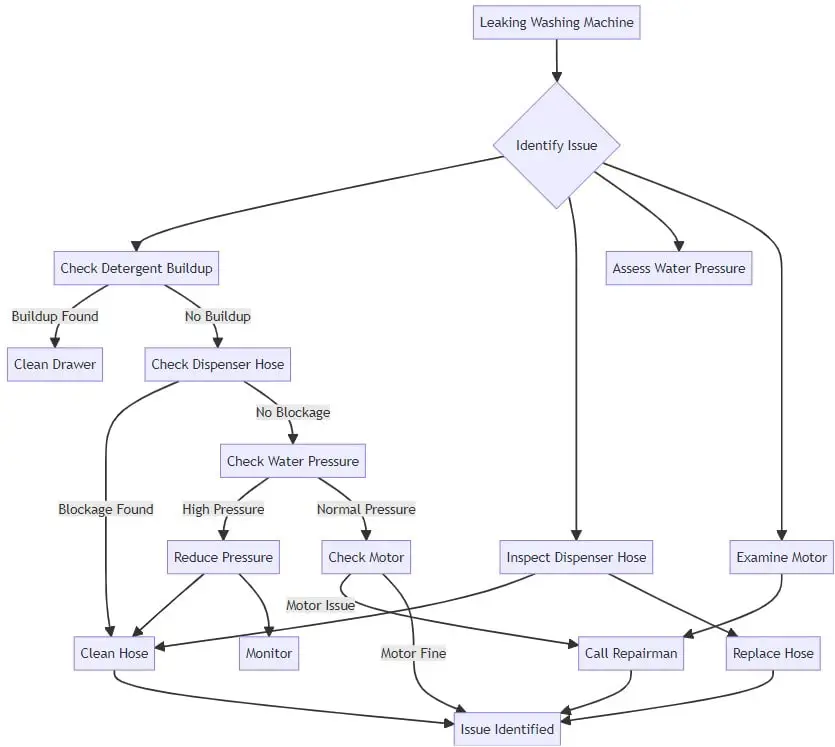The convenience of modern washing machines has revolutionized the way we do laundry, providing efficient cleaning and saving precious time.
However, as with any complex appliance, issues can arise that disrupt the seamless chore of laundry day.
One common and frustrating problem is a washing machine leaking from the drawer when filling.
This issue not only causes an immediate mess but can also lead to potential water damage and operational malfunctions.
In this article, we will explore the causes of this problem, along with effective solutions, and provide tips to prevent such leaks from occurring in the future.
Table of Contents
Washing machine drawer leakage causes and solutions
A leaking washing machine drawer during the filling cycle can be attributed to several underlying causes.
Understanding these potential culprits is essential to accurately diagnose the issue and apply the appropriate solutions. Let’s take a closer look at the common causes of this problem:
Inspect detergent drawer
Over time, detergent residue can accumulate within the detergent drawer, causing blockages and hindering the proper flow of water.
When the water cannot flow freely into the drum, it might overflow and leak from the drawer.
Solution: Remove the Detergent Drawer and Clean Thoroughly
Begin by removing the detergent drawer from your washing machine.
This step allows you to access the inner components and inspect for any visible signs of detergent buildup or debris.
Thoroughly clean the drawer using a mixture of water and mild detergent to remove any accumulated residue.
Pay special attention to the compartments that guide water flow, ensuring they are free from clogs that could hinder water movement.
Also, ensure you’re using High Efficiency (HE) detergent to avoid excessive suds and leaks.
Blocked Dispenser Hose
The dispenser hose, responsible for transferring water from the drawer to the drum, can become blocked due to debris or detergent buildup.
This blockage can lead to a backup of water, resulting in leaks from the drawer.
Solution: Check the Dispenser Hose for Blockages
Examine the dispenser hose that links the washer’s drum to the detergent drawer.
Gently detach it from both ends and examine it for any blockages.
Clear any debris, buildup, or clogs that you encounter.
Running water through the hose can help dislodge and flush out any remaining obstructions. Reattach the hose securely once it’s clean.
High Water Pressure
Excessively high water pressure can overwhelm the system, causing water to flow too forcefully into the detergent drawer.
This can result in water splashing and overflowing, leading to leaks.
Solution: Reduce the Water Pressure to Your Washing Machine
Excessively high water pressure can contribute to leaks from the detergent drawer.
Locate the water supply valve that connects to your washing machine and adjust it to reduce the water pressure.
This can be done by turning the valve partially to decrease the flow of water. Finding the right balance between adequate water supply and manageable pressure is essential.
Faulty Motor
The motor that controls the water intake and distribution might malfunction, causing irregular water flow.
If the motor fails to regulate the water properly, it can contribute to leaks from the drawer.
Solution: Addressing a Faulty Motor
A malfunctioning motor in your washing machine can contribute to water leaks from the drawer during the filling cycle.
If you suspect that the motor is causing the issue, here’s how you can address it:
Diagnostic Check: Before assuming that the motor is faulty, perform a diagnostic check to ensure that the motor is indeed the problem. Check if the motor is making unusual noises or not functioning at all. If the motor is visibly damaged or emits a burning smell, it’s likely malfunctioning.
Professional Repair: Addressing a faulty motor requires specialized expertise. Contact a professional washing machine repair technician to assess the situation. Attempting to repair a motor without proper knowledge can lead to further damage or safety hazards.
Replacement: If the repair technician confirms that the motor is faulty, they will likely recommend a replacement. Motors are intricate components, and it’s best to rely on genuine replacement parts to ensure optimal performance and safety.
Damaged Dispenser Hose
Wear and tear or physical damage to the dispenser hose can create cracks or holes.
These openings can lead to water escaping from the hose and, subsequently, causing leaks from the drawer.
Solution: Addressing a Damaged Dispenser Hose
A damaged dispenser hose can result in leaks from the detergent drawer.
Follow these steps to address a damaged dispenser hose:
Isolate the Machine: First, disconnect the washing machine from its power source and turn off the water supply to prevent any accidents while working on the hose.
Inspect the Hose: Carefully examine the dispenser hose for visible signs of damage, such as cracks, holes, or wear and tear. If you find any issues, it’s necessary to replace the hose.
Obtain a Replacement Hose: Purchase a replacement dispenser hose that is compatible with your washing machine’s make and model. It’s essential to ensure the new hose matches the specifications of the original one.
Replace the Hose: Gently disconnect the damaged hose from both the detergent drawer and the drum. Attach the new hose securely, making sure it’s properly connected at both ends. Ensure there are no kinks or twists in the hose that could impede water flow.
Test for Leaks: After replacing the hose, reconnect the washing machine to the power source and water supply. Run a test cycle without any clothes to ensure that the hose is correctly installed and that there are no leaks.
Check Machine Level and Stability
Before doing advanced troubleshooting make sure your washing machine is steady and level.
If it’s tilting forward, water can leak out, adjust the feet at the bottom of the appliance to level it.
Inspect Inlet Hose
If water is coming from under the washing machine, it might be a leak from the inlet hose.
Check if the inlet hose is loose, and if so, tighten it by hand without overtightening.
Check Fill Hoses
Examine the fill hoses for cracks, damage, or signs of leaking. Replace the fill hoses if they’re leaking, as cracked hoses can cause leaks.
Examine Drain Hose
Inspect the drain hose for cracks or damage and replace it if needed to prevent leaks.
Also, clear any clogs in the house drain to prevent water backup and leaks.
Clean Pump Filter
A clogged pump filter could lead to leaks.
So, clean the pump filter every three months or when it’s clogged to prevent this issue.
The filter is typically located at the bottom right-hand corner of the washing machine
Seek Professional Help if Necessary
If the issue persists despite your efforts, it’s advisable to seek the assistance of a qualified repairman.
A professional technician can diagnose more complex problems such as a faulty motor or a damaged dispenser hose that requires replacement.
Attempting intricate repairs without the right expertise can lead to further complications, so entrust these tasks to experts in the field.
Managing Washing Machine Drawer Leakage in Specific Scenarios
Identifying Soap Dispenser Leaks: Where and When
Understanding the circumstances under which the soap dispenser leaks is crucial to pinpointing the root cause.
Leaks can occur at different stages of your washing machine’s cycle i.e., during filling, washing, rinsing, and even spinning.
By carefully observing when the leakage happens, you can narrow down the possibilities and take appropriate actions.
Leaks During Filling: Potential Culprits and Solutions
Excess water pressure might overwhelm the soap dispenser, resulting in leaks.
To manage this, consider installing a pressure regulator for better flow control.
If your washing machine isn’t level, water could gather around the dispenser area, adjusting the leveling feet will help to keep it balanced on the floor.
Additionally, if the detergent flap is blocked, water won’t flow smoothly, potentially causing leaks.
So, regularly clean the detergent compartment and ensure the flap moves freely to prevent this.
Dealing with Leaks During Washing and Rinsing
Undissolved Detergent
If your detergent doesn’t dissolve completely, it can clog the dispenser’s nozzles, leading to leaks during the wash or rinse cycle.
Switch to high-quality, HE (high-efficiency) detergents that dissolve readily in water.
Blocked Hose
A blocked hose can impede the flow of water and result in leakage during washing or rinsing. Inspect and clean hoses regularly to maintain smooth water circulation.
Understanding Leaks During Spinning: Causes and Fixes
When water drainage is hindered by a partial blockage, leaks can occur during spinning.
This issue often arises after significant water drainage during the wash cycle.
So, clearing any blockages in the drainage system can resolve this.
How to identify leakage types?
At times, water leaks under washing machines can be traced back to the soap dispenser drawer area.
Understanding the root cause of this issue necessitates vigilant observation of water accumulation during the machine’s operation.
To pinpoint the exact source of the leak, a practical approach involves careful observation.
Here’s a general troubleshooting that you can do and no one talks about:
Right Side Wetness – Potential Causes
A wetness on the right side of the machine often indicates the presence of issues related to the pump, hose, seal, or drum.
This part of the machine is connected to crucial components that might be compromised, leading to leaks.
Center Wetness – Possible Causes
If the center of the machine appears wet, this could signify problems with the drum or seal.
Since the center is a vital part of the washing cycle, any malfunction here could lead to water leakage.
Left Side Wetness During Filling – Probable Causes
The left side of the machine showing wetness during the filling process might be indicative of valve, hose, soap box, or hose-related problems.
These components play a pivotal role in managing water flow during the filling phase.
Preventive Tips (Take proactive steps to prevent the leakage problem)
Taking proactive measures to prevent a washing machine from leaking through the drawer when filling can save you the hassle of dealing with repairs and potential water damage.
By following these preventative steps, you can ensure the smooth functioning of your appliance and extend its lifespan:
Use the Correct Amount of Detergent
Using excessive detergent can lead to buildup and clogs in the detergent drawer and dispenser hose.
Follow the manufacturer’s guidelines for detergent usage, and avoid overloading the machine with soap.
Using the right amount of detergent not only prevents clogs but also contributes to cleaner and more efficient washes.
Clean the Detergent Drawer Regularly
Make it a habit to clean the detergent drawer on a regular basis.
Remove any residual detergent and debris to prevent buildup that can impede water flow.
Cleaning the drawer every few weeks will ensure that water can flow freely from the drawer to the drum without any obstructions.
Check the Dispenser Hose for Blockages
Perform routine checks on the dispenser hose every few months.
Inspect it for any signs of debris or blockages that could hinder water flow. If you notice any buildup, remove it promptly to prevent leaks from occurring.
Have Your Washing Machine Serviced Annually
Enlist the services of a qualified repairman to perform annual maintenance on your washing machine.
A professional technician can inspect the various components, including the motor, hoses, and connections, to identify any potential issues before they escalate.
Regular servicing can prevent unexpected breakdowns and leaks.
Monitor Water Pressure
Keep an eye on the water pressure supplying your washing machine.
If you notice excessively high water pressure, consider installing a water pressure regulator to maintain a consistent and safe water flow.
Adequate water pressure prevents forceful water entry that can lead to leaks.
Address Problems Promptly
If you notice any unusual sounds, vibrations, or performance issues with your washing machine, address them promptly.
Delaying repairs can exacerbate the problems and potentially lead to leaks or other malfunctions.
Educate Yourself
Familiarize yourself with your washing machine’s manual and operation.
Understanding how the machine functions and its maintenance requirements can empower you to take better care of it and catch potential issues early.
Illustration diagram for the steps involved in fixing drawer leakage problem

Final Thoughts
Regular maintenance, correct detergent usage, and periodic checks of the dispenser hose and water pressure can help maintain your washing machine’s optimal performance.
Promptly addressing issues through professional assistance when necessary ensures that your appliance remains in top-notch condition.
Remember, a leaking washing machine drawer is not just a minor inconvenience; it can lead to water damage, operational malfunctions, and even mold growth.
Taking the time to identify and resolve the underlying causes can extend the lifespan of your machine and save you from unnecessary expenses down the line.
You May Also Like
- Clean Your Washing Machine Detergent Drawer in 5 Mins
- How To Replace a Washing Machine Detergent Drawer?
- Washing Machine Drawer Not Emptying? Here’s the Fix!
- 3 Compartments in the Washing Machine Drawer (Explained)
- Can you put bleach In Washing Machine Drawer?
- How does an automatic washing machine choose water level?
- How To Replace a Washing Machine Detergent Drawer?
- How to clean Maytag washing machine? (Comprehensive guide)
- How to clean the filter in a Godrej Allure washing machine?
- Why is homemade laundry detergent or soap bad? (Explained)
- What are Plant-based Detergents? (Explained)
- Can Front Load Detergents be used in the Top Load Washers?
- Where do you put the detergent in a Speed Queen?





